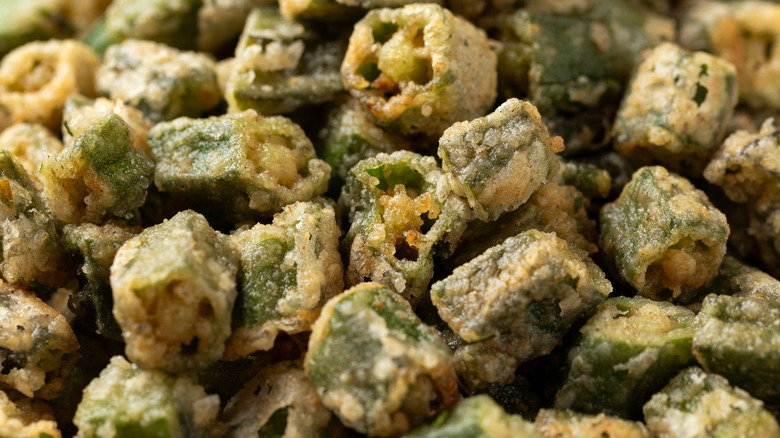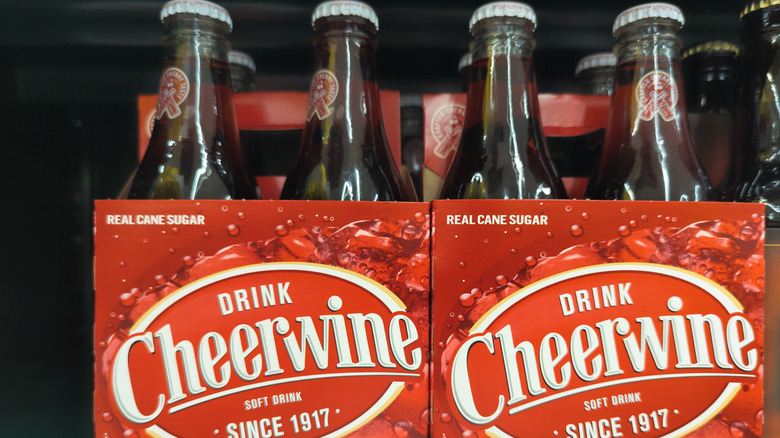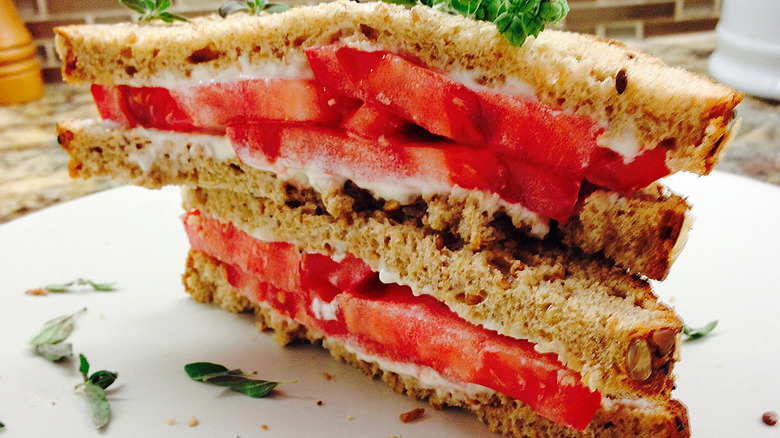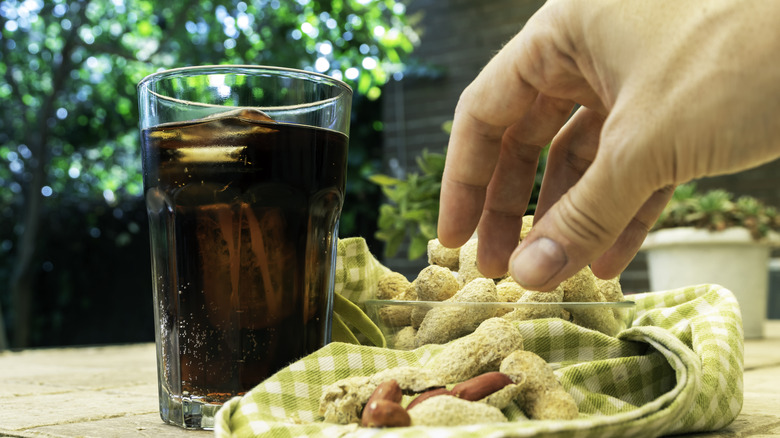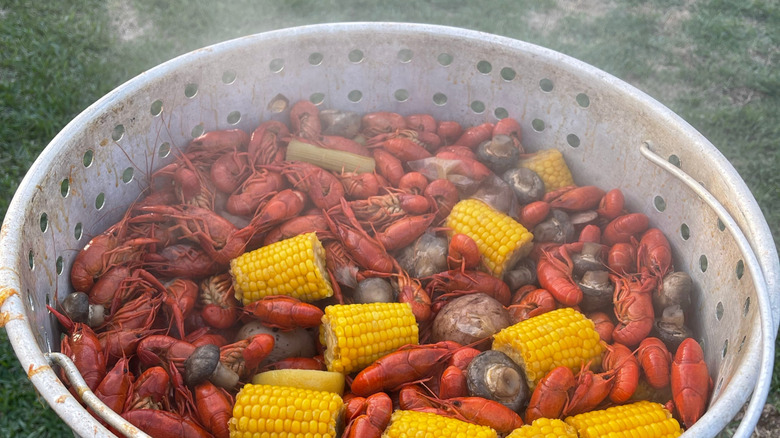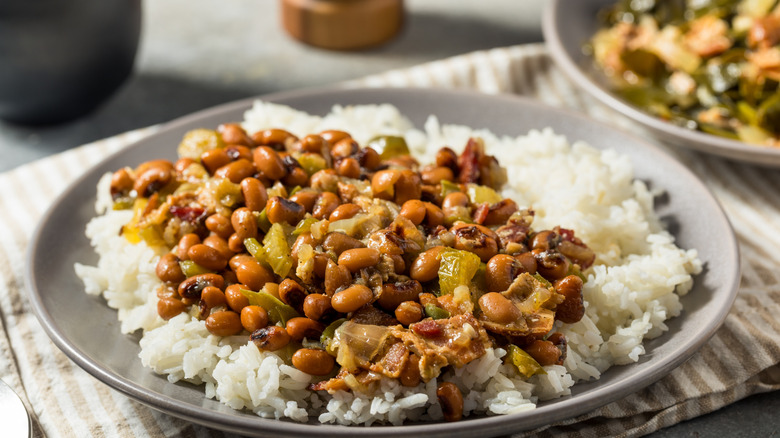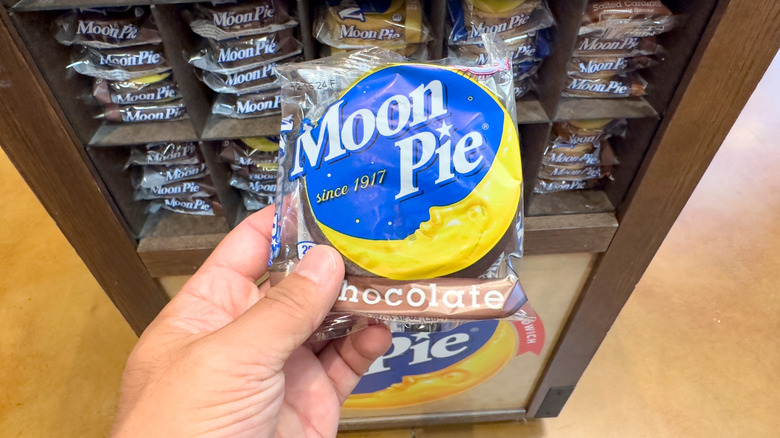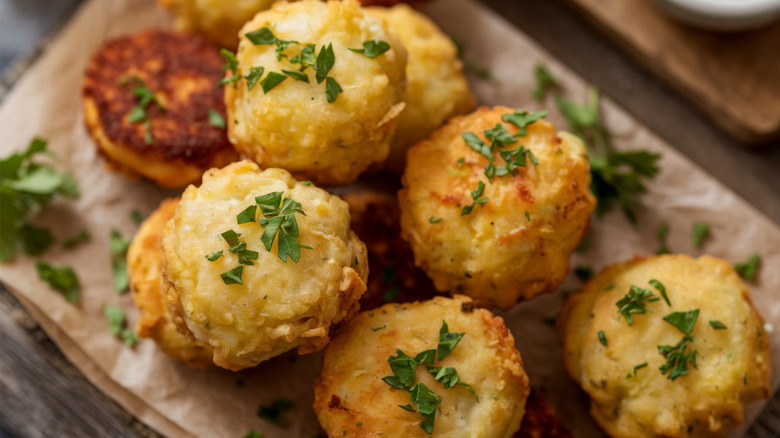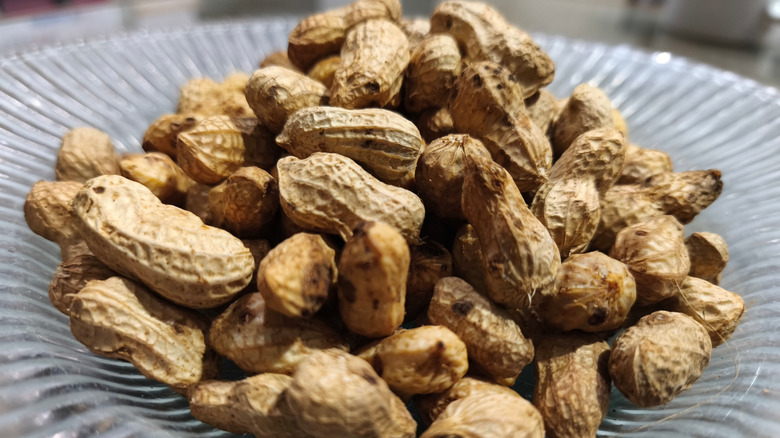If You Ate These 12 Foods As A Kid, You Probably Grew Up In The South
If you've spent time in the South, you might have concluded that a lot of food just tastes better down there. Whether it's the crispy texture of the deep-fried treats or a refreshing sweet tea on a sweltering summer day, the region is known for its culinary specialties and prowess. For people who grew up in the South, the foods from their childhood carry a weighty nostalgia that has been seasoned over time and inherited with love. While vintage Southern foods also evoke many memories, sometimes it's the simplest dishes that take us back the most.
Children who called the South home grew up on fried okra crisped in grandmother's skillet, salty peanuts in sweet soda, spicy gumbo and crawfish boils, and hushpuppies from the fryer, among many other regional delicacies. It was these goodies that were stitched into both everyday moments and special events, and now bring to mind the carefree days of youth. The next time you're craving an authentic taste of the South or want to relive some of your cherished childhood memories, consider adding these classic foods to your list.
Fried okra
In the South, fried okra is more than just a side dish. The crispy veggies are a cultural heirloom passed down through many generations. Okra is rooted in African and Southern agricultural traditions, given new life when covered in a crispy, crunchy batter. The vegetable arrived in the U.S. via the transatlantic slave trade and was revered by farmers for its resilience in hot climates. Cooks loved it for its versatility in the kitchen. Even Southern children who wouldn't eat their vegetables inhaled the fried treat with enthusiasm.
While okra is cherished for its thickening power in gumbos and stews, it was often fried in rural Southern kitchens since cornmeal was affordable and plentiful. The green vegetable was sliced into coin-shaped pieces, tossed in a seasoned cornmeal batter, and deep fried. The satisfying crunch helped to conceal its naturally slimy texture, making it more appealing to kids. People who were raised in the South most likely remember fried okra served alongside crispy catfish or chicken during Sunday suppers, family reunions, or special occasions.
Cheerwine
Also known as the Nectar of North Carolina, Cheerwine was created in 1917 in the Southern United States. The wild cherry-flavored soda has a deep burgundy hue (a little like wine) and bold sweetness. If you grew up in this region, you'll know that Cheerwine is a Southern staple, often enjoyed at family reunions, picnics, or during dinnertime. The sugary cherry flavor offers a refreshing contrast to fried and spicy foods, and the soda serves as an alternative to sweet tea.
Cheerwine was born out of necessity when sugar was in short supply due to World War I. The drink's unique flavor and affordable price made it particularly popular in rural Southern communities. Over the years, the soda has become synonymous with Southern hospitality, and many people have fond memories of enjoying a cold bottle of Cheerwine at church potlucks and backyard barbecues. It is also a common sight on roadside diner menus, alongside dishes like hushpuppies and fried catfish. Not only a beloved beverage, Cheerwine is also used as a surprising ingredient in sweet treats such as doughnuts and cupcakes.
Pimento cheese
Rich, creamy, and spreadable, pimento cheese didn't actually originate in the South. Nevertheless, the dish's history has far-reaching roots in the region. Pimento cheese's story began in the late 19th century, with the original combination of unripened cheese and red peppers. Later, the soft cheese was replaced by cream cheese. The thick pimento cheese spread became popular across the U.S. after Good Housekeeping published a recipe in 1908, but the South developed a particular fondness for it. Several variations of pimento cheese have emerged on the culinary scene since the early 1900s, but a recipe featuring cheddar cheese and rich mayonnaise has remained a Southern favorite.
The combination of cream cheese and pimentos was so delectable that it was mass-produced and sold in stores. The addition of regional spices, such as cayenne pepper, gave it a distinctive kick. Children who grew up in the South most likely recall scooping pimento cheese onto crackers and chips. The tradition of pimento cheese sandwiches is alive and well, frequently found in Southern lunchboxes or alongside other delicate finger foods at tea parties, church functions, and holiday soirees.
Tomato sandwiches
Some say that summer hasn't officially arrived in the South until you've had your first bite of a juicy tomato sandwich. Traditionally consisting of white bread, mayonnaise, and thick slices of garden tomatoes, these seasonal sandwiches were the stars of Southern children's lunches. Although the origins of this simple dish are uncertain, one publication referenced the Southern delicacy as far back as 1911. Although tomato sandwiches sound basic, some Southerners insist that a few rules must be followed when preparing this staple. For the best taste, it's important to use the big, meaty heirloom tomatoes that pop up at local markets or in gardens during the summer. Since the sandwich doesn't contain other ingredients like meat or cheese, cut the tomatoes into substantial slices for a satisfying bite.
Southerners are also picky about the type of bread you use for these summertime sandwiches. Most people will tell you that good old-fashioned white bread is the only option for tomato sandwiches. Of course, you can still use whole wheat, rye, or any other type of bread you'd like without going to sandwich jail. Just be sure to slather the top and bottom slices with thick layers of mayonnaise, preferably a Southern brand such as Duke's or New Orleans-based Blue Plate. One bite of a tomato sandwich will send any Southerner on a trip down memory lane.
Peanuts in Coke
If you didn't grow up in the South, the thought of eating roasted peanuts straight out of a cold Coke bottle might make you scratch your head, but it's been a regional treat since the early 20th century. Dropping a few peanuts into a chilled bottle of Coca-Cola is a Southern tradition steeped in nostalgia, and the sweet and salty combination has an addictive quality. This dynamic duo is thought to have originated in the 1920s as a roadside shop ritual that gained popularity among working-class Southerners. In particular, factory workers and farmers needed fast, one-handed snacks during long, tiring shifts. With their hands either dirty or occupied, the workers could simply pour a few of the savory peanuts into a refreshing Coke and have both a snack and a sip at the same time.
Eventually, the sweet and salty pick-me-up gained popularity among kids, who relished the fizzy, crunchy treat. What makes the combo ingenious even today is the way the salt of the peanuts cuts through the soda's syrupy sweetness, turning two humble snacks into a few moments of joy shared across generations. Even if you're not originally from the South, you can still try funneling a bag of the salty nuts into your next bottle of Coke.
Crawfish boil
If you spent your childhood in the American South, particularly in Louisiana, many of your early memories might center around festive crawfish boils. The culinary tradition dates back to ancient America, when Indigenous peoples would roast various types of seafood and vegetables over fire pits. With the arrival of Creole and French influences, new spices and cooking methods were added to the practice. Finally, as seafood became cheaper and more widely available by the mid-20th century, the beloved crustaceans made their way into Southern cookbooks.
Crawfish boils are now a beloved tradition, especially in Louisiana's Cajun communities, where people celebrate the bounty of the land in a variety of ways. Throughout history, crawfish, also known as crayfish or, in Southern Louisiana, mudbugs, have been plentiful in local bayous and swamps, making them the natural choice for communal feasts. The humble backyard crawfish boil includes ingredients such as zesty seasonings, sausage, corn on the cob, potatoes, vegetables, and seafood. These preparations have transformed into large social events, complete with long, newspaper-covered tables, boiling pots of goodness, and plenty of laughter and storytelling. One tip for throwing the best backyard crawfish boil (and reliving your childhood memories) is to use live crawfish and frozen corn.
Hoppin' John
Hoppin' John is another traditional dish that many Southerners grew up with. Blessed with a distinctive, lively name, Hoppin' John has roots that run deep into the history of Caribbean, African, and Carolina Lowcountry cuisine. The plate is typically made with black-eyed peas, rice, and some type of pork, such as bacon or ham hock. Although folklore tells many origin stories for this dish and its name, it most likely originated among African American slaves in the coastal South, where rice was a thriving regional crop. The ingredients, although humble and easily accessible, blended beautifully.
In the South, Hoppin' John is commonly served on New Year's Day. When served with greens and cornbread, which respectively symbolize money and gold, the plate is believed to bring prosperity and good fortune. The dish also reflects West African symbolic food pairings, which often combine legumes and grains for sustenance and good luck. A soul food staple, Hoppin' John traditionally contains the three base vegetables in many Cajun dishes –– celery, onion, and bell pepper –– along with chicken broth.
MoonPies
For children in the American South, sweet MoonPies were considered lunchbox heroes as well as snacks, desserts, and maybe even breakfast –– but who's judging? According to the legend as told by MoonPie, the treat shot onto the culinary scene in 1917, when Kentucky coal miners asked Earl Mitchell, a Chattanooga bakery salesman, for a hearty and delicious snack that was "as big as the moon." Mitchell sandwiched a marshmallow filling between two graham cracker cookies and dipped the combination into rich chocolate, per the miners' request. In the early days, MoonPies were priced at just a nickel and conveniently sized to be big enough for a meal but still fit into lunch pails.
The handheld desserts were first popularized among the working class, but soon reached the general public when they were sold in country stores and gas stations, alongside RC Cola for washing them down. Many Southern children also enjoyed them at county fairs and roadside diners throughout the region. Today, they're still popular chocolatey treats and are sometimes thrown in Mardi Gras parades. You can try making these beloved Southern goodies at home with graham crackers, a jar of marshmallow fluff, and melted chocolate.
Hushpuppies
Even today, you'd be hard-pressed to find a traditional Southern restaurant that doesn't serve golden brown hushpuppies. They're often enjoyed alongside other popular dishes like seafood platters and fried catfish. The crunchy balls with a soft, savory center originated in resourceful Southern kitchens where the affordable and easily accessible cornmeal reigned supreme. Like many cherished Southern dishes, hushpuppies trace their origins to Indigenous and African American cooking traditions, although the snack became popularized during the Civil War era. Cornmeal batter was dropped into the leftover hot oil from fish fries to create the crispy, savory bites. Folklore states that the dish's whimsical name was born when the fried cornmeal balls were tossed to barking dogs with the command to "Hush puppy!"
Hushpuppies reflect the Southern tradition of thrift in the kitchen and the region's love of cornmeal, fried food, and communal cooking. Although hushpuppies are also beloved side dishes for adults, kids can't resist the finger food with a fun moniker and delightfully savory bite. If you want to try whipping up a platter at home, consider serving hushpuppies with lemon honey butter.
Red beans and rice
For those who grew up in the Deep South, particularly in Louisiana, you likely associate a bowl of red beans and rice with a feeling of nostalgia. One possible origin story for the dish dates back to historic New Orleans, where the meal became a staple on Mondays, which was often wash day. Since the chore was so labor-intensive, little time was left for preparing anything elaborate. Cooks could throw some red beans in a pot, along with the ever-popular Creole base of diced onions, bell peppers, and celery, and let the ingredients simmer all day while they completed housework. A leftover ham bone or some smoky sausage added depth to the dish, and fluffy white rice rounded out the meal.
The warm, comforting dish reflects the influence of Creole and Caribbean spices, African legume traditions, and French and Spanish rice-cooking techniques. Over time, it became a symbol of Southern thrift and flavor, served in homes, school cafeterias, and corner diners alike. Today, red beans and rice remain a soulful reminder of how necessity, community, and culture can simmer together to create meaningful memories.
Funeral sandwiches
Despite funeral sandwiches' unusual and downright morbid name, the Southern treats are actually comforting, handheld meals. These soft rolls are filled with common ingredients that are found in almost every refrigerator and pantry across the South. Traditional fillings include ham, some type of cheese, a touch of tangy mustard, poppy seeds, and a lot of Southern hospitality. If you called the South home during your formative years, there's a good chance you sank your teeth into a funeral sandwich. And yes, you probably had them at funerals, but they were also served at several other formal functions, including weddings, holiday parties, and banquets.
The origin of funeral sandwiches is tied to church kitchens and community gatherings, where food is offered up for comfort as well as sustenance. Funeral sandwiches were also perfect potluck snacks, as they were easy to prepare in bulk and could be either served at room temperature or warmed up in the oven. When baked at home, wrapped in foil, and delivered to funeral homes or other community events as after-service meals, the sandwiches were an easy and tasty way to show some love to friends and family.
Boiled peanuts
Boiled peanuts are a soft and salty snack with deep roots in Southern history, especially across the states of Georgia, Alabama, and the Carolinas. The snack was popular sustenance for soldiers during the Civil War era, but it was most likely brought to the U.S. through the transatlantic slave trade. Boiled peanuts' legacy begins in African culinary traditions, where the legumes were typically cooked in salted water for hours to soften and flavor them. In the American South, raw green peanuts were also cooked or roasted to make them easier to snack on. Since raw peanuts spoil quickly, boiling them became an easy way to extend the shelf life of the cheap and protein-rich snack.
Over time, they became a symbol of Southern hospitality and rural pride, and were cherished for their rich, earthy flavor and briny bite. Many Southerners' childhood memories no doubt include hanging around large pots of peanuts, which were often boiled outdoors over open fires. If you're craving a salty taste of childhood, you can still find boiled peanuts at roadside stands, gas stations, and ball games throughout the South. They're best enjoyed with family and friends at tailgate parties, festivals, and other gatherings.

